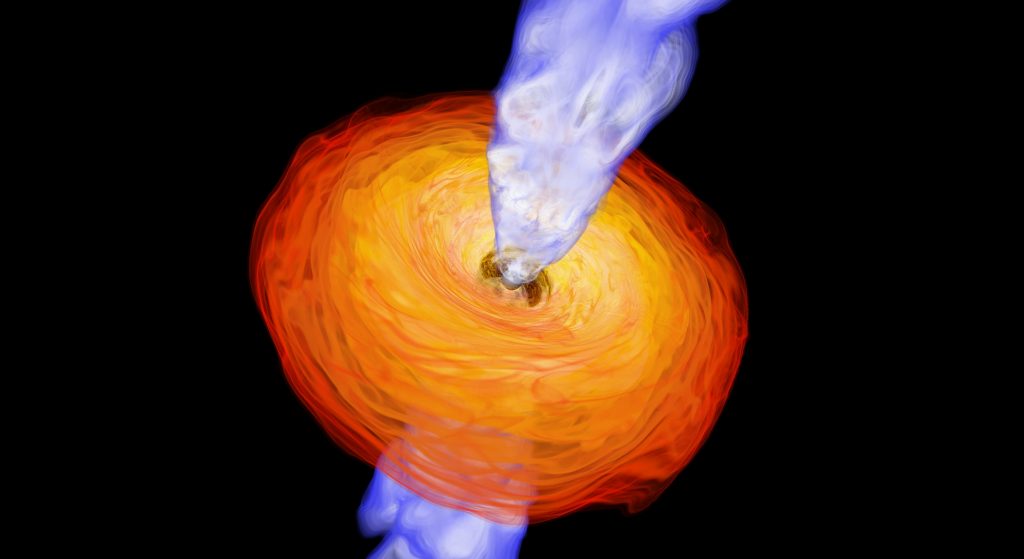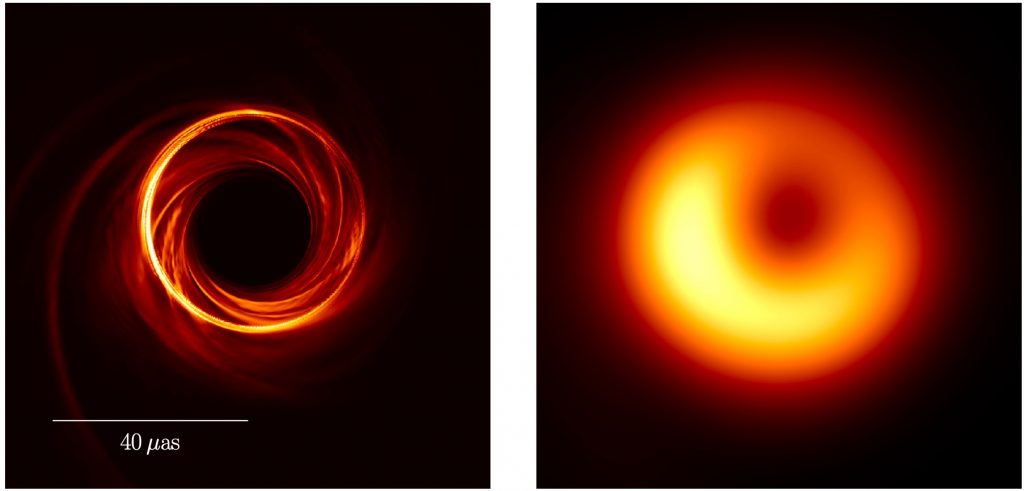
The collimated relativistic plasma jet flow is frequently seen from the center of relativistic objects such as active galactic nuclei (AGNs), microquasar, pulsar wind nebulae, and Gamma-Ray Bursts (GRBs). However, the formation mechanism has not yet well-undertood. From previous theoretical studies, the most promising mechanism is magnetohydrodynamic (MHD) process.
In 2004, we have performed general relativistic magnetohydrodynamic (GRMHD) simulations of collapsars (rotating massive stars) as a central engine of GRBs and shown the jet-like outflow is formed at the first time through MHD process (Mizuno et al. 2004a,2004b).
In 2007, we have performed GRMHD simulations of geometrically thin disk rotating around a black hole by using newly developed GRMHD code RAISHIN. We presented the formation of two-component (fast spine-slow sheath) jets due to black hole spin effect (Hardee et al. 2007). Using this GRMHD simulation data. we have calculated actual radiation image (black hole shadow) from black hole accretion disk system by thermal synchrotron emission using general relativistic radiation transfer (GRRT) code in post-processing (Wu et al.2008).

From 2015, theoretical modelling of black hole shadow from GRMHD simulation coupling with post-processed GRRT calculation is continuously investigated in the international collaboration of EHT (Goddi et al. 2017, Porth et al. 2017, Mizuno et al. 2018, Davelaar et al. 2019, van der Gucht et al. 2020, Olivares et al. 2020, Bronzwaer et al. 2021). Especially, in Davelaar et al. (2019), we considered on-thermal electron distribution function for radiation calculation through Kappa-jet model. We try to parameter estimation from synthetic black hole shadow images from GRMHD model through machine learning technique (van der Gucht et al. 2020). These researches are advanced from the approach in EHT collaboration work for M87 (EHT collaboration et al. 2019).
Most of recent GRMHD simulations (Porth et al. 2017) are considered weak single poloidal magnetic loop in the accretion torus. How affect the magnetic field configuration? We have performed the GRMHD simulations of magnetized torus with multiple magnetic field loops (Nathanail et al. 2020). If the magnetic loops have different polarity, magnetic fields are reconnected and multiple plasmoid is created. This is different picture from ordinary single magnetic loop case.
From analytical studies, we have investigated accretion onto a black hole and relativistic jets from stagnation surface with large-scale magnetic field (Pu et al. 2015) and the particle transport and non-thermal radiation from the relativistic jet base in the vicinity of black hole (Pu et al. 2017).
3D AMR GRMHD simulations are powerful tool for performing jet formation to propagation in large scale. We have developed theoretical pipeline by coupling with post-processed GRRT calculation and model comparison & parameter estimation technique. This is theoretical pipeline is important for theoretical work for EHT collaboration (EHT collaboration et al. 2019).
References:
- Mizuno et al. 2004, ApJ, 606, 395
- Mizuno et al. 2004, ApJ, 615, 389
- Hardee et al. 2007, ApSS, 311, 281
- Wu et al. 2008, CJAA Sup., 8, 226
- Goddi et al. 2017, IJMPD, 26, 173001
- Porth et al. 2017, Comp. Astro. Cos. 4, 1
- Mizuno et al. 2018, Nature Astronomy, 2, 585
- Davelaar et al. 2019, A&A, 632, A2
- van der Gucht et al. 2020, A&A, 636, A94
- Olivares et al. 2020, MNRAS, 497, 521
- Bronzwaer et al. 2021, MNRAS, in press
- EHT collaboration, Akiyama et al. 2019, ApJ, 875, L5
- Nathanail et al. 2020, MNRAS, 495,1549
- Pu et al. 2015, ApJ, 801, 56
- Pu et al. 2017, ApJ, 845, 160
